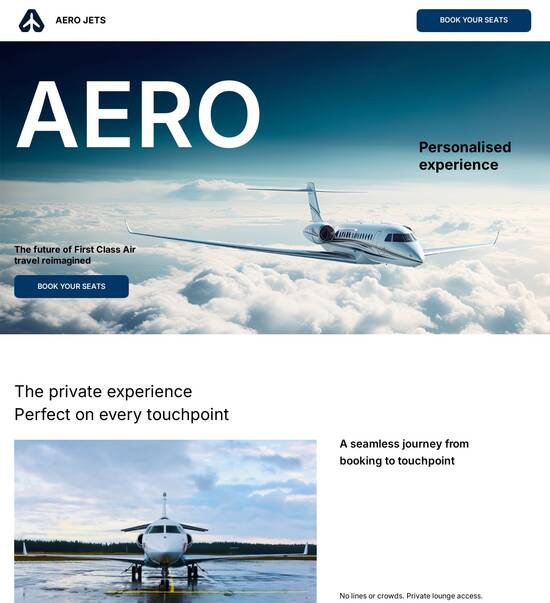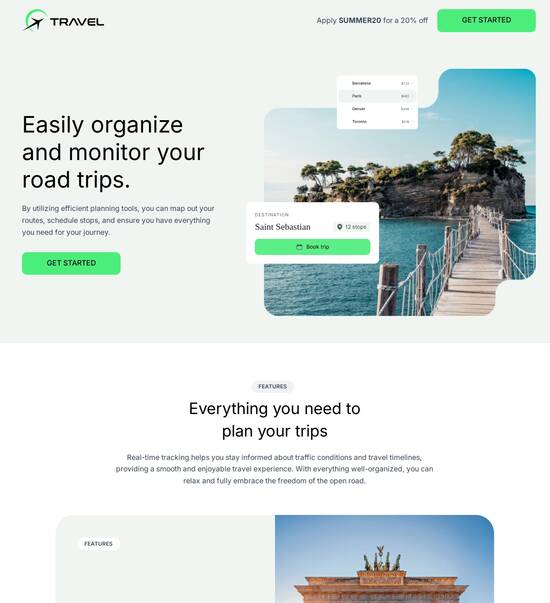
Material design web page templates
Use TemplateAbout template
Master the art of web design with material design web page templates. Transform your business today!
Recommended templates

Easy to build without coding
With the intuitive drag-and-drop builder, anyone on your team can create high-converting pages without any knowledge of code or design. Make enhancements to your landing page with custom widgets using Javascript, HTML/CSS, or third-party scripts.

Multiple layouts for any industry and goal
Select from 500+ landing page layouts built to boost conversions across industry-specific scenarios. Customize them by adjusting fonts, adding images, and generating on-brand content with the AI assistant. Quickly scale with Instablocks® and Global Blocks that you can save, reuse, and update globally.

Loads fast and looks polished on any device
Every template is responsive, which means they present professionally on any device and load blazingly fast with our Thor Render Engine. You can also power them up with Google AMP technology to deliver an unparalleled mobile experience and drive higher conversions.

Robust analytics & experimentation
Get real-time updates and reporting across all your devices, showing the number of visitors, conversions, cost-per-visitor, and cost-per-lead. Launch AI-powered experiments, run A/B tests, and use heatmaps to analyze user behavior, then optimize your landing page to maximize conversions.







Easy to build without coding
With the intuitive drag-and-drop builder, anyone on your team can create high-converting pages without any knowledge of code or design. Make enhancements to your landing page with custom widgets using Javascript, HTML/CSS, or third-party scripts.
Multiple layouts for any industry and goal
Select from 500+ landing page layouts built to boost conversions across industry-specific scenarios. Customize them by adjusting fonts, adding images, and generating on-brand content with the AI assistant. Quickly scale with Instablocks® and Global Blocks that you can save, reuse, and update globally.
Loads fast and looks polished on any device
Every template is responsive, which means they present professionally on any device and load blazingly fast with our Thor Render Engine.
Robust analytics & experimentation
Get real-time updates and reporting across all your devices, showing the number of visitors, conversions, cost-per-visitor, and cost-per-lead. Launch AI-powered experiments, run A/B tests, and use heatmaps to analyze user behavior, then optimize your landing page to maximize conversions.
All the features you need to build material design website template
Explore more featuresLearn how to build google material design website examples
Frequently asked questions about material design web template
Leading the way in building high-performing landing pages





Material design template: Your ultimate how-to guide
In today's competitive digital landscape, marketers need tools that accelerate their campaigns and optimize conversion rates. Instapage, as a leading landing page and conversion rate optimization platform, empowers businesses to create high-converting pages quickly and efficiently. Whether you're in education, financial services, or tech, Instapage offers tailored solutions to help you achieve your marketing goals.
Understanding the Importance of Landing Pages
Effective landing pages serve as the backbone of your marketing strategy. They capture leads, guide visitors, and ultimately drive conversions. With Instapage's extensive library of pre-built templates, marketers can easily create landing pages tailored to their audience needs without requiring coding skills.
- High-converting templates: Choose from over 100 ready-to-use designs that cater to various industries.
- Seamless integrations: Connect effortlessly with your favorite marketing tools to streamline your workflow.
- Mobile responsiveness: Ensure your landing pages look great on any device, enhancing user experience.
Step 1: Crafting Compelling Landing Pages
Creating an effective landing page begins with understanding your target audience. Use data insights to determine what speaks to your potential customers and align your messaging accordingly. Utilize Instablocks to customize your layout for peak performance.
Step 2: Optimizing for Conversions
Once your landing page is set up, optimization is key. Utilize built-in heatmaps to analyze user behavior and iterate based on real-time data.
- A/B testing: Experiment with different headlines and calls to action to see what converts best.
- Analytics dashboard: Track vital metrics to assess performance and adapt your strategy.
- Personalization tools: Use dynamic text replacement to create tailored experiences for distinct audience segments.
Step 3: Collaborating for Success
Collaboration speeds up the page production process. Instapage allows teams to provide real-time feedback and conduct edits simultaneously, ensuring that everyone is aligned and informed.
- Instant feedback: Facilitate discussions and feedback loops directly on the page interface.
- Secure sharing: Collaborate with external stakeholders without risking security.
- Version control: Maintain track of edits and ensure the latest version is always accessible.
In conclusion, an intuitive landing page created with Instapage not only enhances user engagement but also drives marketing success through conversion optimization.
Ready to take your marketing campaigns to the next level? Start your free trial today with Instapage and experience unparalleled landing page optimization.
People also ask about material website template
Material design web page templates: A comprehensive guide
Understanding material design: A paradigm shift in web page templates
Material design has fundamentally changed the landscape of web design by offering a cohesive and modern aesthetic compatible with various platforms. Originating from Google, this design philosophy encourages the integration of bold colors, clean lines, and strategic layouts. The impact of material design can be observed in its comprehensive approach to creating user interfaces, combining visual and tactile elements that enhance user experiences across devices.
The essence of material design
Material design is defined as a design language that establishes a visual and interactive framework to improve user experience. Historically, it marks an evolution from flat design, emphasizing depth, shadows, and layers. This shift reflects the growing demand for functional, narrative-driven UIs that offer more than mere aesthetics.
Integration of physical properties into digital environments.
Smooth transition between different design philosophies.
Focus on user-centric interfaces that narrate a story.
The driving forces behind material design include innovative thinkers at Google, whose contributions have led to principles governing interaction, form, and behavior in the digital space. These principles promote a sense of continuity, encouraging seamless navigation and engaging experiences.
Core principles of material design
Key principles of material design guide designers in creating visually appealing user interfaces. These principles make it easier to communicate information and provide clear pathways for users. Understanding these core elements ensures designers effectively leverage them in web page templates.
Hierarchy and emphasis
Visual hierarchy is crucial in UI designs, as it establishes a prioritization of content. This ensures users can quickly identify important information. Strategies include varying the size, color, and placement of key elements to guide users through web pages intuitively.
Material as metaphor
Material design uses physical properties as metaphors for digital interactions, creating a familiar navigational experience. Real-world analogies enhance usability, providing users with a framework to understand navigation intuitively.
Bold, graphic, intentional
Vivid colors and graphic elements form the foundation of material design. By using bold colors and creative shapes, designers can create impactful visuals, making sites more attractive and engaging.
Motion provides meaning
Animation plays a pivotal role in enhancing the user experience by providing context and continuity. Effective motion design can guide users’ attention, offering cues that facilitate interaction and make transitions smoother.
Exploring material design web page templates
Material design web page templates serve as a scalable framework for designing responsive sites. Various HTML5 frameworks allow developers to create visually appealing designs that maintain performance and usability, leading to successful online presence.
HTML5 frameworks for responsive design
HTML5 offers robust advantages, including support for multimedia elements and improved semantic structure. Leading HTML5-based templates leverage these qualities, ensuring that web pages load quickly and provide responsive layouts across devices.
Bootstrap: A popular HTML5 framework known for its responsive grid system.
Materialize CSS: A CSS framework based on material design principles.
Foundation: Offers advanced responsive capabilities for modern web design.
Customization is a key feature of these templates, allowing marketers to align designs closely with their brand identity. Successful implementations often showcase the effectiveness of combining unique branding elements with established material design principles.
Accessibility and usability features
Ensuring inclusivity is paramount in material design. Key considerations include color contrasts for readability and keyboard navigation for accessibility. Best practices offer guidelines that promote usability, making it easier for diverse audiences to engage and interact with web content.
Use semantic HTML and ARIA roles to enhance accessibility.
Test designs with users who have disabilities to identify pain points.
Regularly update accessibility features to align with new standards.
Effective accessibility features are not just compliance requirements; they enhance overall user experience and extend audience reach.
Harnessing material design for product development
Incorporating material design into product development workflows promotes enhanced collaboration between designers and developers. This relationship ensures consistency, ultimately leading to more cohesive product experiences.
Tools and technologies support material design implementation in diverse environments, ranging from standard libraries to specialized software aiding testing and prototyping. As these tools evolve, they make integrating material design principles into product development seamless and efficient.
Material design system: A unified approach
A comprehensive design system encapsulates material design concepts into frameworks enabling consistent application across platforms. Defining a design system establishes guidelines for components, ensuring clarity and uniformity in products.
Component libraries streamline design processes.
Design tokens provide a consistent visual language.
Documentation fosters understanding and application of material principles among teams.
The benefits of this unified approach culminate in products that are not only visually appealing but also offer users a seamless experience across platforms.
The impact of material design on website aesthetics
Aligning visual elements with brand identity is crucial for effective marketing. Material design facilitates this alignment through structured layouts, coherent color schemes, and typography that resonate with target audiences.
Visual clarity enhances brand recognition.
Emotional responses are fostered through aesthetic cohesion.
Material design principles enhance usability, leading to increased customer loyalty.
Brands adopting material design not only capture attention but also create lasting impressions through compelling visual narratives.
The pragmatic benefits of implementing material design templates
Improving user experience is fundamental in web design. Effective UI designs facilitate navigation, minimizing cognitive load. Users quickly find the information they need, enhancing overall satisfaction.
Enhanced loading speed and performance
Technical aspects of material design templates support quick loading times, further contributing to user retention. Employing optimized code within HTML5 frameworks ensures that elements load seamlessly across devices.
SEO benefits associated with structured HTML5 code
Structured HTML5 code enhances website rankings by facilitating search engine crawling. By implementing best practices in coding and design, organizations can achieve better visibility and user engagement.
Designing for tomorrow: Future trends in material design
As material design continues to evolve, future trends will likely integrate emerging technologies. AI and chatbots can provide user assistance tailored to individual needs, enhancing overall interactivity.
Voice user interface (VUI) trends reshape interaction paradigms.
Augmented reality (AR) influences online shopping experiences.
Personalized user interactions drive engagement and conversions.
Staying ahead by embracing these advancements will enable brands to harness material design's full potential.
Real-world applications: Showcasing robust demo templates
The versatility of material design web page templates can be seen across numerous industries. Highlighting innovative use cases manifests in ecommerce, education, and service-oriented sectors optimizing their user interfaces.
Comparative analysis of various material design templates
Evaluating templates based on usability, customization, and performance can help businesses identify the most suitable solutions. User testimonials often illustrate real-life experiences, showcasing the utility and effectiveness of different designs.
Conclusion: Embracing the material revolution
The significance of material design in modern web development is profound. It encourages designers to approach projects with a mindset of innovation and user-centric focus, enhancing the overall quality of digital products.
As designers and developers adapt to this evolving landscape, material design will continue to shape digital experiences, providing grounded, engaging, and effective solutions for users.
Ready to skyrocket conversions?
Supercharge your ad campaigns with high-performing landing pages
Get started














